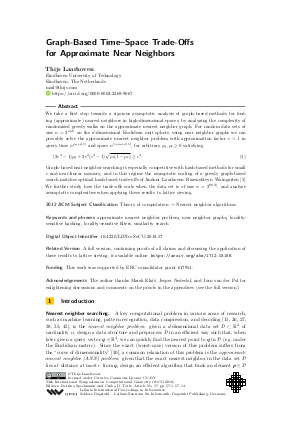Graph-Based Time-Space Trade-Offs for Approximate Near Neighbors
Author Thijs Laarhoven
-
Part of:
Volume:
34th International Symposium on Computational Geometry (SoCG 2018)
Part of: Series: Leibniz International Proceedings in Informatics (LIPIcs)
Part of: Conference: Symposium on Computational Geometry (SoCG) - License:
 Creative Commons Attribution 3.0 Unported license
Creative Commons Attribution 3.0 Unported license
- Publication Date: 2018-06-08
File

PDF
LIPIcs.SoCG.2018.57.pdf
- Filesize: 0.59 MB
- 14 pages
Document Identifiers
Subject Classification
Keywords
- approximate nearest neighbor problem
- near neighbor graphs
- locality-sensitive hashing
- locality-sensitive filters
- similarity search
Metrics
- Access Statistics
-
Total Accesses (updated on a weekly basis)
0Document
0Metadata
Abstract
We take a first step towards a rigorous asymptotic analysis of graph-based methods for finding (approximate) nearest neighbors in high-dimensional spaces, by analyzing the complexity of randomized greedy walks on the approximate nearest neighbor graph. For random data sets of size n = 2^{o(d)} on the d-dimensional Euclidean unit sphere, using near neighbor graphs we can provably solve the approximate nearest neighbor problem with approximation factor c > 1 in query time n^{rho_{q} + o(1)} and space n^{1 + rho_{s} + o(1)}, for arbitrary rho_{q}, rho_{s} >= 0 satisfying (2c^2 - 1) rho_{q} + 2 c^2 (c^2 - 1) sqrt{rho_{s} (1 - rho_{s})} >= c^4. Graph-based near neighbor searching is especially competitive with hash-based methods for small c and near-linear memory, and in this regime the asymptotic scaling of a greedy graph-based search matches optimal hash-based trade-offs of Andoni-Laarhoven-Razenshteyn-Waingarten [Andoni et al., 2017]. We further study how the trade-offs scale when the data set is of size n = 2^{Theta(d)}, and analyze asymptotic complexities when applying these results to lattice sieving.
Cite As Get BibTex
Thijs Laarhoven. Graph-Based Time-Space Trade-Offs for Approximate Near Neighbors. In 34th International Symposium on Computational Geometry (SoCG 2018). Leibniz International Proceedings in Informatics (LIPIcs), Volume 99, pp. 57:1-57:14, Schloss Dagstuhl – Leibniz-Zentrum für Informatik (2018)
https://doi.org/10.4230/LIPIcs.SoCG.2018.57
BibTex
@InProceedings{laarhoven:LIPIcs.SoCG.2018.57,
author = {Laarhoven, Thijs},
title = {{Graph-Based Time-Space Trade-Offs for Approximate Near Neighbors}},
booktitle = {34th International Symposium on Computational Geometry (SoCG 2018)},
pages = {57:1--57:14},
series = {Leibniz International Proceedings in Informatics (LIPIcs)},
ISBN = {978-3-95977-066-8},
ISSN = {1868-8969},
year = {2018},
volume = {99},
editor = {Speckmann, Bettina and T\'{o}th, Csaba D.},
publisher = {Schloss Dagstuhl -- Leibniz-Zentrum f{\"u}r Informatik},
address = {Dagstuhl, Germany},
URL = {https://drops.dagstuhl.de/entities/document/10.4230/LIPIcs.SoCG.2018.57},
URN = {urn:nbn:de:0030-drops-87700},
doi = {10.4230/LIPIcs.SoCG.2018.57},
annote = {Keywords: approximate nearest neighbor problem, near neighbor graphs, locality-sensitive hashing, locality-sensitive filters, similarity search}
}
